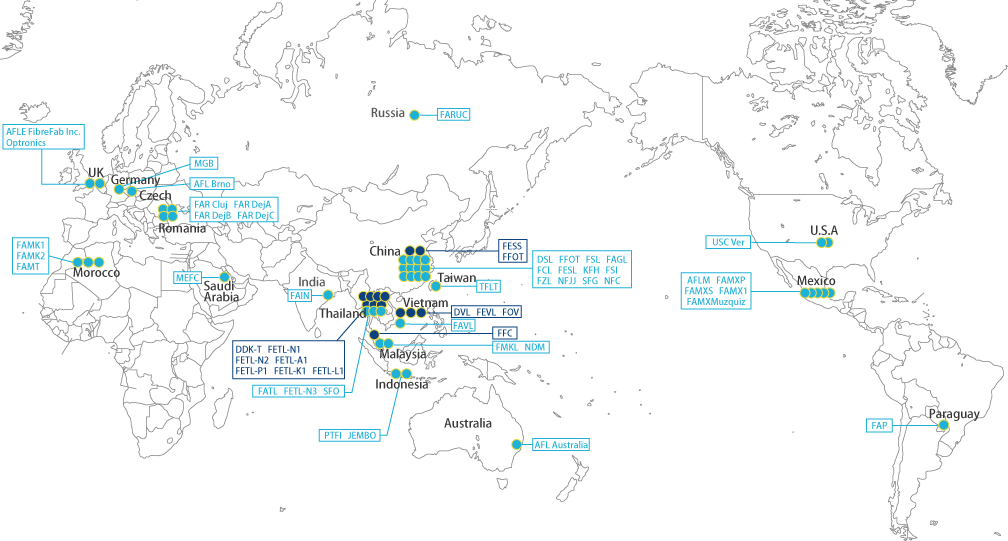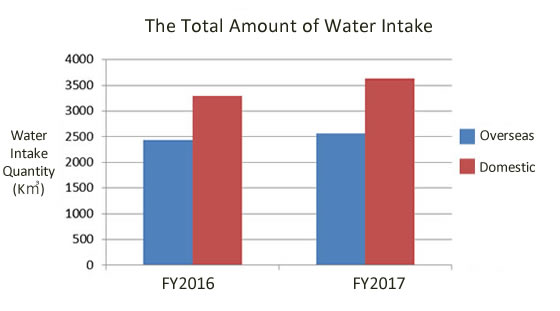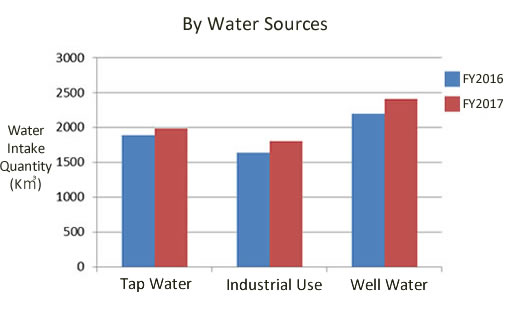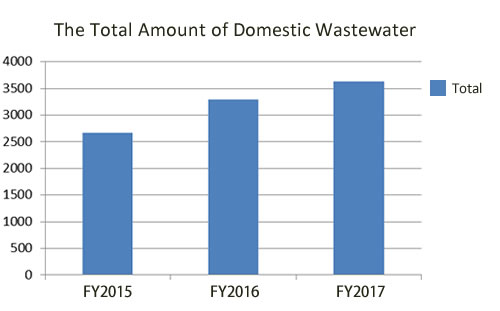Responding to Water Risks
Policies and Guidelines for Water Risks
In order to respond to water risks, the Fujikura Group has set "minimization of water use in factories and drainage management" as a challenge item of the long-term environmental vision 2050. Regarding minimization of water use at the factory, we are promoting activities using "not used, repeated use, clean and return to nature" as a word. Regarding wastewater management, we recommend installing a constant monitoring system of "pH", "Oil content" and "Turbidity" in the final drainage tar- get for domestic manufacturing bases.
In the "Environmental Management Guidelines 5th Edition" that received the Environmental Long-term Vision 2050, we aim to reduce water consumption intensity by more than 1% compared to the previous fiscal year in domestically consolidated companies, and to reduce water consumption, recycling, leakage countermeasures, etc. We are.
Water Risk Field and the Group's Business Development
The World Water Access Plan (WWAP) in the 2016 "The United Nations World Water Development Report" used the Food and Agriculture Organization's (FAO) database, "AQUASTAT", to analyze the strain of water demand from the net precipitation vs. population in 2014 (=water stress*). While informing about the strain put on a country's demand for water in relation to net precipitation vs. the population, the study promotes even more study into regional deviations and Cross-boundary waters of large nations, and thinking about balancing seasonal supply and demand while considering water stress on the water basin.
The figure is from 2014, but the water risk is rising in areas like Africa, China, India, and Europe. The Fujikura Group has business developments in China, India, and Europe and responses to the water risk will become necessary.
- *Water stress: The water necessary per person for agriculture, industry, and energy in a year is 1,700m3. When supply goes below that amount, the condition is called "water stress." When the amount goes below 1,000m3 the condition is "water inadequacy," and when it goes below 500m3, the condition is "absolute water inadequacy".
Fujikura Group's Overseas Base (FY2017)
|
|
Water Risks That Occurred at Group Bases in the Past
In the Fujikura Group, the manufacturing base in the Kingdom of Thailand suffered great damage (flood damage) due to the flood that is said to occur in Thailand in 2011, once in 50 years. After that, we made declaration of reconstruction from the flood in 2016, but as a lesson learned, we are promoting diversification of manufacturing bases in neighboring countries and installation of waterproof walls. Since then, in Thailand, we have been working on floods and droughts as part of BCP activities. Regarding the selection of new bases, we have thoroughly investigated and decided past floods and elevations.
2017 Efforts
Total Water Intake in Japan and Overseas, Water Withdrawal by Water Resources, Usage
The Fujikura Group has the same number of water intake and usage for business activities.
Regarding intake water, there is no drought water stress in the country, but as a preventive measure against floods, we are implementing legislation, increasing rainwater gutters, strengthening the tide banks and so on.
Water consumption in fiscal 2017 increased both domestically and overseas in fiscal 2016. The reason for the increase was mainly due to increased production, and well water, wastewater and industrial water increased slightly by water source. Meanwhile, domestically, sales were reduced by 1% or more on a per-unit basis, achieving the goals set in the 5th edition of the Environmental Activity Management Guidelines, and improving production efficiency.
|
|
|
Domestic Wastewater Volume
Domestic wastewater volume for fiscal 2017 increased from fiscal 2016. The reason for the increase was mainly due to increased production. About drainage of domestic bases, automatic monitoring of pH, turbidity and oil content at the final drainage is carried out at almost all bases.
|
|



